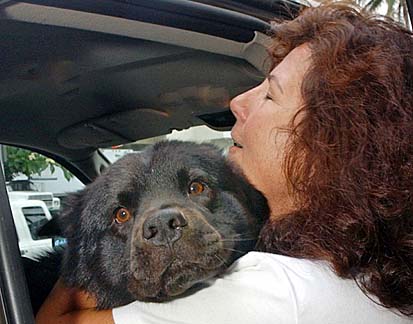
Terry Ramey gives her black chow, Walaze, a hug after the pet makes the trip from Las Vegas to be reunited with Ramey at Honolulu Airport. Walaze qualified for direct release from quarantine.
New quarantine rules
seen as success
Terry Ramey counted down the days before she would once again see her beloved Walaze, the dog she left behind when she moved to Aiea.
During their emotional reunion earlier this month at Honolulu Airport, Ramey literally swept her black chow off his feet before being flooded with sloppy, wet kisses.
"I was so happy I thought I was going to pass out," she said.
A little more than a year ago, that scene would have taken place at the state's quarantine facility at Halawa. But this week marks one year since Hawaii eased its strict rabies quarantine regulations, allowing qualified pets to be released to their owners shortly after they arrive in Hawaii -- in five days or less -- instead of requiring them to be quarantined for up to four months.
In the year since Gov. Linda Lingle signed the new rules, pet owners have flocked to Hawaii, with a record 6,600 cats and dogs admitted in the fiscal year ending tomorrow, up from 4,681 in the previous year.
Pet owners must still plan ahead. The process that allows them to take pets home from the airport must begin at least four months before they arrive. If not, their pets are still subject to a stay in the state quarantine facility.
Dr. James Foppoli, the state veterinarian, said most pets have qualified for the new five-day-or-less program with 75 percent released directly to their owners at the airport facility.
Foppoli said he had predicted the new process would allow about half the arriving pets to enjoy shortened stays.
"It's a little bit surprising, but I guess for people it's worth the effort to get everything done so there's no confinement," he said.
Lingle said she was pleased with how effectively the five-day-or-less quarantine rules have been implemented in the first year.
"Having had a pet go through the old quarantine process, I know the stress that was placed on the animal and the pet owner," said the governor, whose cockapoo dog, Spooky, spent four months in quarantine when Lingle moved to Hawaii in 1975. "The modernized quarantine rules have made it much more convenient for people to travel to and from the islands with their pets, while still ensuring Hawaii remains rabies-free."
Before last July, arriving animals faced a minimum 30 days of quarantine in state kennels.
Hawaii's quarantine was imposed in 1912 to prevent rabid animals from entering the then-U.S. territory. Revised rules adopted in 1997 reduced the minimum confinement to 30 days from 120 days, but a month-long separation still took an emotional toll on both owners and pets, not to mention the hefty costs.
Pets that have received rabies vaccinations, have electronic microchip identification and have a blood test showing a rabies vaccination response, under the state's strict guidelines, are allowed to bypass quarantine.
Pets that do not meet the new early-release rules are subject to confinement of 30 days if vaccination and testing requirements are met, or 120 days if they are not.
Only about 12 percent of all current animals being processed by the state go through the 120-day quarantine, which was the norm before 1997, officials said.
Ramey said her move to Hawaii was unplanned, so she did not have time to get Walaze's final rabies shot in time to bring him with her. Instead of placing him in quarantine, she decided to leave her dog with friends in Las Vegas for a few months.
"If I had pre-planned my relocation and didn't leave so abruptly, it would've been a walk in the park," she said.
— ADVERTISEMENTS —
— ADVERTISEMENTS —
